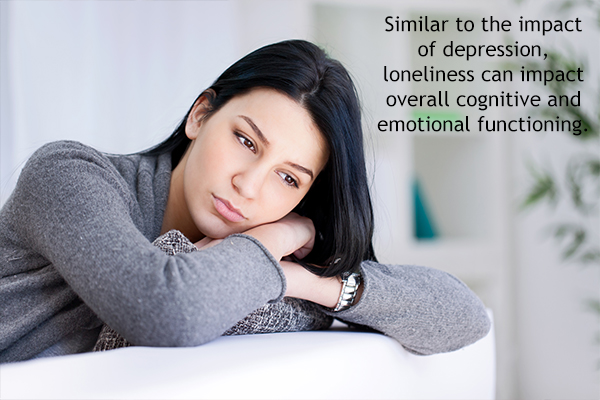In this article:
Loneliness is characterized by a state of enduring sadness that results from being alone.

While loneliness is often associated with social isolation, an individual does not necessarily have to be socially isolated from others to feel alone. For example, an individual can be surrounded by crowds and still feel lonely.
This highlights the importance of meaningful social connections with others. When a person feels a sense of connection with others, they are at a decreased risk of experiencing loneliness.
Meaning of Situational and Chronic Loneliness
Loneliness is viewed as either situational or chronic, which signifies a time parameter on this state of sadness.
1. Situational loneliness
Situational loneliness is temporary and likely passes after a short period. Examples of situational loneliness might include the temporary sadness that results when a loved one leaves home for a trip, and the person left behind experiences sadness that lingers for hours to days.
2. Chronic loneliness
Chronic loneliness, on the other hand, is a persistent state of sadness that can last indefinitely with no clear end in sight. An example of this might include the heartache that results from the permanent loss of a loved one, including by death for example.
Chronic loneliness can last from weeks to months and years. The longer chronic loneliness persists, the more vulnerable an individual is to negative health outcomes.
Chronic loneliness may be perceived as a condition that is exclusive to elderly populations. However, younger generations are not immune to this emotional state. Chronic loneliness may be experienced differently by the elderly and younger populations, but both groups are affected nonetheless.
Common Causes of Chronic Loneliness

Little is known about casual links to loneliness (Courtin & Knapp, 2015). (1) Loneliness is a state of sadness related to social isolation, and the following risk factors contribute to it:
- Poor social connections
- Limited social support systems
- Decreased economic resources
- Changes in family structures
All of these scenarios may impact younger and older populations alike, such as:
- Limited to non-existent opportunities to connect with others (e.g., do not have friends or acquaintances to connect with)
- Inability to participate in social opportunities due to limited resources (e.g., not having money to participate in social clubs that have membership fees)
- Major shifts in family dynamics (e.g., death of a loved one)
Research focuses heavily on elderly experiences of loneliness as this group is known to be susceptible to all of the above, specifically as it relates to major life transitions associated with retirement and bereavement. (2)
Signs and Symptoms of Chronic Loneliness
Psychiatric diagnoses are informed by the Diagnostic and Statistical Manual of Mental Disorders, Fifth Edition (DSM-5, 2013). While there is no formal DSM-5 diagnosis of chronic loneliness, this condition may be generally associated with depression and depressive disorders. (3)(4)
Symptoms of depression and similarly chronic loneliness may include:
If you believe you are experiencing any of these symptoms, it is important that you consult a primary care provider or mental health professional.
Treatment for Chronic Loneliness
Despite the extant research conducted on social isolation and loneliness, more research is needed to better understand the overall impact of specific interventions that affect loneliness and health. There is no exclusive treatment protocol for loneliness.
However, because chronic loneliness is considered to have similar processes as depression, treatment interventions that are effective in treating depression may also be found helpful in improving chronic loneliness.
Such interventions relate to evidenced-based cognitive behavioral therapy approaches, including socially informed behavioral activation (e.g., encouraging others to engage in new activities that involve others).
Addressing loneliness in clinical practice is something practitioners (both medical and mental health professionals) can be mindful of in the assessment and treatment of their patient populations.
Diagnosis of Chronic Loneliness
Psychiatric diagnoses are informed by the Diagnostic and Statistical Manual of Mental Disorders, Fifth Edition (DSM-5, 2013). While there is no formal DSM-5 diagnosis of chronic loneliness, this condition may be generally associated with depression and depressive disorders. (5)
Higher levels of loneliness are associated with increased depressive symptoms. The DSM-5 characterizes depression by the presence of a sad, empty, or irritable mood, accompanied by changes in both physical and cognitive abilities. (6)
A study demonstrated that social connections with others decrease the risk of chronic loneliness and depression. (7) If you experience any of the symptoms of chronic loneliness or depression, consult a primary care provider or mental health professional right away.
Ways to Prevent Chronic Loneliness
It is my belief that humans are created to be in relation with others.
As highlighted in Abraham Maslow’s (1943) hierarchy of needs theory, feeling loved, and having a sense of belonging are human necessities. (8) When this is absent, it can create a state of stress and loneliness and can lead to poor mental and physical health.
A preventative measure to avoid chronic loneliness is involvement in activities that foster social connectedness. This may vary based on:
- Age
- Culture
- Environmental context
General activities that may increase social connectedness include:
- Web-based interventions (e.g., social media, email, video platforms to communicate with friends and family)
- Group interventions (e.g., social clubs, sporting clubs, video games)
Long-Term Effects of Chronic Loneliness on Mental Health

Similar to the impact of depression, loneliness can affect overall cognitive and emotional functioning.
- Cognitive impact: The impact of depression on cognitive functioning includes impairment in attention, concentration, and memory abilities. This applies to chronic loneliness, too. For example, when individuals experience significant depression or loneliness, they are likely to have issues paying attention to certain details, are prone to making errors and mistakes at work, and have a difficult time recalling specific events and conversations.
- Emotional impact: Individuals who are chronically lonely may report feeling significantly more moody, irritable, angry, impatient, and tearful, just to name a few. The same patterns of impaired functioning and behaviors that accompany depression symptoms may exist with chronic loneliness.
- Comorbidity: Chronic loneliness can co-occur with, as well as exacerbate, other preexisting mental conditions.
- Suicidal tendencies: Depression is a significant risk factor for suicidal behaviors. As such, socially disconnected and lonely individuals are at an increased risk of suicide. (9)
Health Risks Associated With Loneliness
Studies have suggested both situational and chronic loneliness may be risk factors for mortality or death, although chronic loneliness presents a much higher risk (Shiovitz & Ayalon, 2010). (10)
Loneliness is a risk factor for poor mental and physical health. Depression and cardiovascular health are the most studied health outcomes of chronic loneliness (Courtin & Knapp, 2015). (1)(4)
As mentioned earlier, most studied health outcomes of chronic loneliness include depression and cardiovascular issues. (4)
Research on the gender-based impact of loneliness has produced mixed results. Various studies indicate that men and women respond differently to social isolation and loneliness. For example, Zebhauser et al. (2013) identified that while loneliness affects both men and women, loneliness has a more deleterious impact on men. (11)
Additionally, Hackett et al. (2012) identified that loneliness affects the physical health of women more than that of men. (12)
Final Word
Loneliness often stems from the absence of a rewarding social life and emotionally satisfying relationships, but it can very well affect people who are doing well on both these accounts. Thus, loneliness cannot always traced back to a discernible cause.
Some people suffer periodic episodes of loneliness that may be triggered by a recent event, while others are riddled with constant, unexplained loneliness.
Chronic loneliness not only diminishes your sense of self-worth and self-confidence, but also paves the way for heart problems and depression. Thus, you must not dismiss your emotional health as unimportant as it can significantly hamper your physical and mental health in the long run.
Get help from trained medical and mental health professionals to cope with this disorder and lead fulfilling lives.
- Was this article helpful?
- YES, THANKS!NOT REALLY


